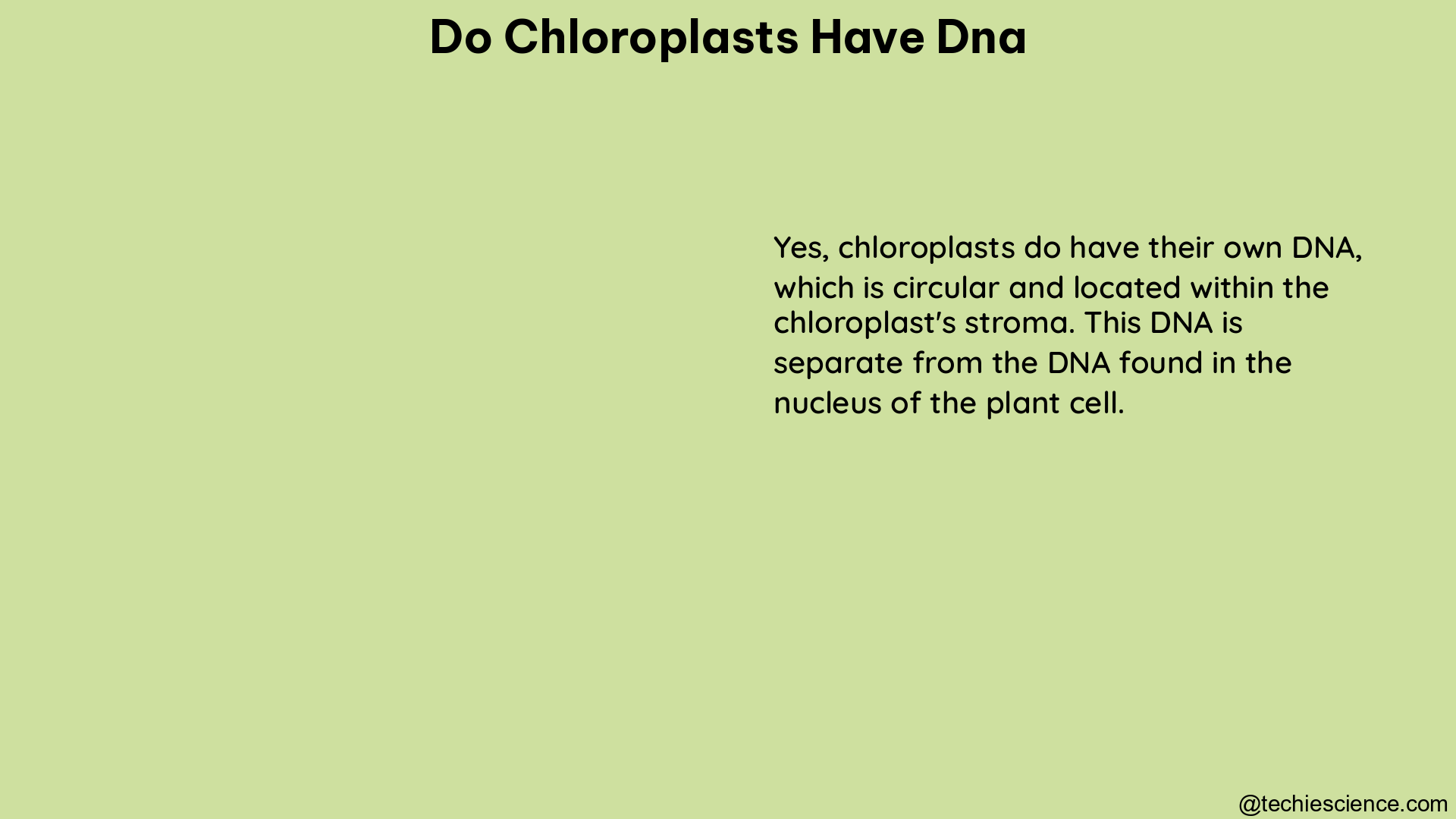Chloroplasts, the organelles responsible for photosynthesis in plant cells, are known to possess their own genetic material, distinct from the nuclear DNA. This chloroplast DNA (ctDNA) plays a crucial role in the functioning and maintenance of these essential cellular structures. In this comprehensive blog post, we will delve into the intricacies of chloroplast DNA, exploring its characteristics, significance, and the implications of its presence in plant cells.
The Presence and Structure of Chloroplast DNA
Chloroplasts do indeed possess their own DNA, which is present in multiple copies within each chloroplast. This chloroplast DNA is a small, circular, double-stranded molecule that is typically found in the stroma, the fluid-filled space within the chloroplast.
The size of the chloroplast genome varies among different plant species, ranging from around 120,000 to 160,000 base pairs. This genetic material is compact, with a high gene density, and it encodes a diverse array of genes essential for the chloroplast’s function.
The Copy Number of Chloroplast DNA

The number of copies of chloroplast DNA (ctDNA) within each chloroplast can vary significantly, depending on the plant species and the developmental stage of the cell. Studies have shown that the copy number of ctDNA can range from as low as 3 copies per plastid to as high as 275 copies per plastid in leaf cells of different developmental stages in some species. In certain plant species, the copy number can even reach upwards of 10,000 or more copies per leaf.
This high copy number of chloroplast DNA is a crucial factor in the field of chloroplast genetic engineering. The abundance of ctDNA provides a compelling basis for the introduction and expression of foreign genes within the chloroplast, as the high copy number can theoretically lead to high expression levels of the introduced genes.
The Genetic Content of Chloroplast DNA
The chloroplast genome encodes a wide range of genes that are essential for the chloroplast’s function and the overall photosynthetic process. These genes can be broadly categorized into the following groups:
-
Photosynthesis-related genes: The chloroplast genome contains genes that encode for proteins involved in the light-dependent and light-independent reactions of photosynthesis, such as the components of the photosynthetic electron transport chain and the enzymes involved in carbon fixation.
-
Gene expression-related genes: The chloroplast genome also encodes genes for the machinery involved in the transcription and translation of chloroplast-encoded proteins, including genes for ribosomal RNAs, transfer RNAs, and various RNA polymerase subunits.
-
Chloroplast division and maintenance genes: The chloroplast genome contains genes that regulate the division and replication of chloroplasts, ensuring the proper segregation and inheritance of these organelles during cell division.
-
Other essential genes: In addition to the above-mentioned categories, the chloroplast genome also encodes genes involved in various other cellular processes, such as lipid biosynthesis, amino acid metabolism, and the synthesis of essential cofactors.
The Significance of Chloroplast DNA
The presence of chloroplast DNA has several important implications for plant biology and biotechnology:
-
Photosynthesis and chloroplast function: The genes encoded by the chloroplast genome are crucial for the proper functioning of the chloroplast and the overall photosynthetic process. Any disruptions or mutations in these genes can have significant impacts on the plant’s ability to perform photosynthesis and maintain cellular homeostasis.
-
Chloroplast biogenesis and division: The chloroplast genome contains the genetic information necessary for the division and replication of chloroplasts, ensuring the proper inheritance and distribution of these organelles during cell division.
-
Chloroplast genetic engineering: The high copy number of chloroplast DNA and the presence of a distinct genetic system within the chloroplast make it an attractive target for genetic engineering. Chloroplast transformation has been explored as a means to introduce and express foreign genes, potentially leading to improved crop traits or the production of valuable biomolecules.
-
Evolutionary significance: The presence of chloroplast DNA, along with its distinct genetic features, provides insights into the evolutionary origins of chloroplasts. Chloroplasts are believed to have originated from cyanobacteria-like organisms that were engulfed by ancient eukaryotic cells, a process known as endosymbiosis. The chloroplast genome retains remnants of this evolutionary history, offering clues about the evolutionary relationships between chloroplasts and their cyanobacterial ancestors.
Conclusion
In summary, chloroplasts do indeed possess their own DNA, which is present in multiple copies within each chloroplast. The number of copies of chloroplast DNA can vary significantly among different plant species and developmental stages, with some species having as many as 10,000 or more copies per leaf. This chloroplast DNA encodes a diverse array of genes essential for the chloroplast’s function, including those involved in photosynthesis, gene expression, and chloroplast division. The presence of chloroplast DNA has important implications for plant biology, chloroplast function, and biotechnological applications, such as chloroplast genetic engineering. Understanding the characteristics and significance of chloroplast DNA is crucial for advancing our knowledge of plant cellular biology and exploring its potential applications in various fields of study.
References:
- Bock, R. (2007). Structure, function, and inheritance of plastid genomes. In Cell and Molecular Biology of Plastids (pp. 29-63). Springer, Berlin, Heidelberg.
- Maliga, P. (2004). Plastid transformation in higher plants. Annual review of plant biology, 55, 289-313.
- Sugiura, M. (1992). The chloroplast genome. Plant molecular biology, 19(1), 149-168.
- Timmis, J. N., Ayliffe, M. A., Huang, C. Y., & Martin, W. (2004). Endosymbiotic gene transfer: organelle genomes forge eukaryotic chromosomes. Nature Reviews Genetics, 5(2), 123-135.
- Wicke, S., Schneeweiss, G. M., dePamphilis, C. W., Müller, K. F., & Quandt, D. (2011). The evolution of the plastid chromosome in land plants: gene content, gene order, gene function. Plant molecular biology, 76(3-5), 273-297.

Hello, I am Bhairavi Rathod, I have completed my Master’s in Biotechnology and qualified ICAR NET 2021 in Agricultural Biotechnology. My area of specialization is Integrated Biotechnology. I have the experience to teach and write very complex things in a simple way for learners.